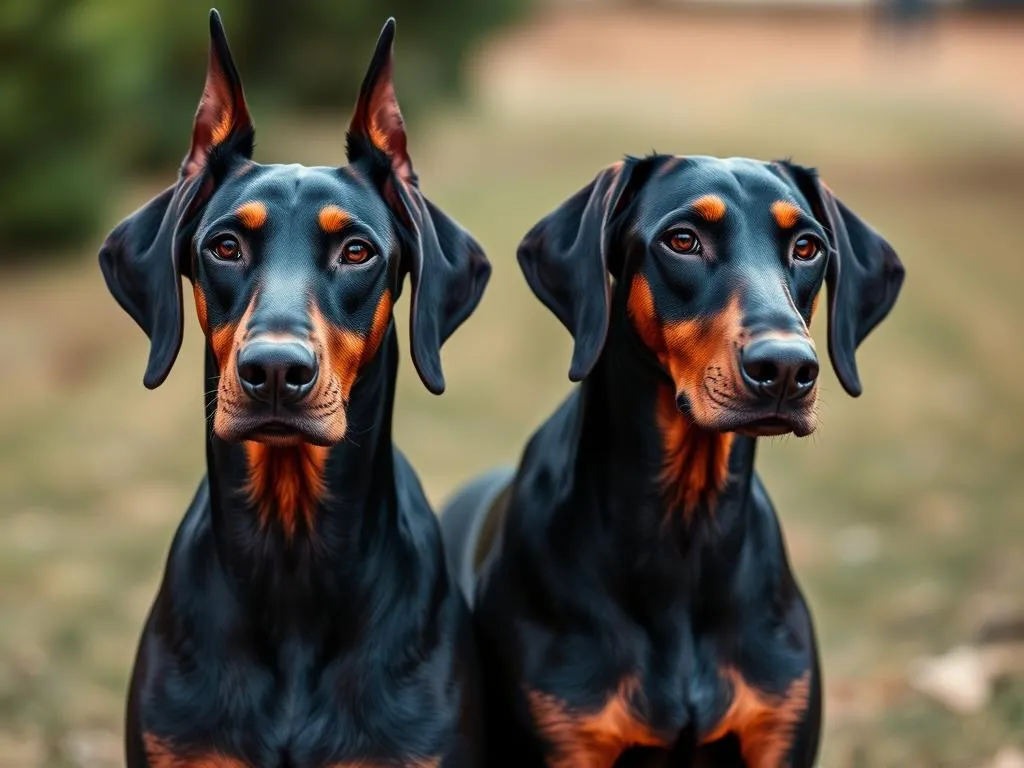
Dobermans are one of the most recognized and beloved dog breeds, known for their loyalty, intelligence, and striking appearance. One of the most distinguishing features of Dobermans is their coat color, which plays a significant role in their overall aesthetic and breed standards. Understanding common Doberman colors helps potential owners appreciate the breed’s diversity and make informed choices when selecting a companion.
Understanding Doberman Colors
Genetics of Coat Color
The coat color of Dobermans is determined by genetics, specifically by the combination of alleles inherited from their parents. The primary genes that influence coat color in dogs are the extension and agouti genes. For Dobermans, the most recognized colors are the result of specific genetic combinations. The common Doberman colors—black and rust, red and rust, blue and rust, and fawn and rust—are all expressions of these genetic factors.
When breeding Dobermans, it’s essential to understand how these genes interact. For example, a black Doberman inherits genes that prevent the expression of lighter colors, while the rust markings are produced by a different set of genes. This genetic interplay is crucial in determining not just the color but also other traits of the breed.
Why Coat Color Matters
Coat color is not merely a cosmetic feature; it holds significance in terms of breed standards set by kennel clubs. Each recognized color has specific guidelines, and deviations can result in disqualification in conformation shows. Additionally, some studies suggest potential associations between coat color and health or temperament, although these claims require further research.
Common Doberman Colors
Black and Rust
The black and rust Doberman is perhaps the most iconic representation of the breed. This color pattern features a sleek black coat with striking rust markings on the face, chest, legs, and paws. The contrast between the black and rust is visually stunning, making this coloration the most popular among Doberman enthusiasts.
Beyond their appearance, black and rust Dobermans are often celebrated for their strong temperament and loyalty. These dogs are commonly seen in various roles, including service and protection work, due to their intelligence and trainability.
Red and Rust
Red and rust Dobermans are characterized by a rich, reddish-brown coat complemented by rust markings. This coloration is sometimes mistaken for brown, but the hues are distinctly brighter and more vibrant. Red Dobermans are known for their expressive eyes, which can range from dark to lighter shades, enhancing their overall appearance.
Compared to their black counterparts, red and rust Dobermans are slightly less common but still highly sought after. They share similar temperament traits with black and rust Dobermans, making them exceptional companions and working dogs.
Blue and Rust
The blue and rust variation is one of the more unique Doberman colors. The blue coloration results from a dilution gene that lightens the black pigment, giving it a grayish-blue appearance. Like the other colors, blue Dobermans feature rust markings that provide contrast.
However, it’s worth noting that blue Dobermans can be prone to specific health issues, particularly skin conditions and a higher sensitivity to environmental factors. Prospective owners should be aware of these considerations when choosing this striking coloration.
Fawn and Rust
The fawn and rust Doberman is similar to the blue variation, as it also results from a dilution of color. Fawn Dobermans have a pale, yellowish-brown coat with rust markings. This coloration is rare compared to the more common black and red varieties, making fawn Dobermans particularly sought after by collectors and enthusiasts.
There are common misconceptions surrounding fawn Dobermans, particularly regarding their temperament and health. Some people believe that fawn Dobermans may be more prone to health issues; however, many fawn Dobermans are healthy and have temperaments similar to their black and red counterparts.
Rare Doberman Colors
Chocolate and Rust
The chocolate and rust Doberman is a relatively rare color variation characterized by a rich, dark brown coat with rust markings. While this coloration is not officially recognized by all breed standards, it has gained popularity among breeders and enthusiasts.
Chocolate Dobermans can be hard to find, and breeders specializing in this color may charge a premium. Additionally, potential owners should ensure that they are purchasing from ethical breeders who prioritize health and temperament over color.
White Doberman
The white Doberman is perhaps one of the most controversial color variations. These dogs are not truly white but rather have a light cream coat due to a genetic mutation associated with albinism. White Dobermans often have pinkish noses and light blue eyes, which adds to their unique appearance.
However, the albinism gene can lead to various health issues, including vision problems and increased sensitivity to sunlight. As a result, many breeders and breed organizations do not recognize white Dobermans as a standard color, and responsible breeding practices should be followed to avoid health complications.
Other Variations
Beyond the commonly recognized and rare colors, there are also other variations of Dobermans, including merle patterns and brindle markings, though these are not typically accepted within the standard. The rarity of these colors often results from irresponsible breeding practices and a lack of understanding of genetics.
Factors Influencing Doberman Color
Breeding Practices
Selective breeding significantly impacts the common Doberman colors seen today. Responsible breeders prioritize not only the desired coat color but also the health and temperament of the dogs. Ethical breeding practices involve understanding the genetic background of both parents, ensuring a healthy lineage, and adhering to breed standards.
Unfortunately, some breeders may focus solely on color, leading to potential health risks and temperament issues in the puppies. It’s essential for prospective owners to research breeders thoroughly and choose those who prioritize the overall well-being of the dogs they produce.
Environmental Factors
Environmental factors can also influence the appearance of a Doberman’s coat. For instance, exposure to sunlight can cause fading in some colors, particularly in blue and fawn Dobermans. Seasonal variations may also affect coat condition, with many dogs experiencing changes in texture and sheen during different times of the year.
Maintaining a proper diet rich in essential nutrients can help keep a Doberman’s coat healthy and vibrant, regardless of color.
Choosing the Right Doberman Color
Personal Preference
When selecting a Doberman, personal preference plays a significant role. Some people are drawn to the classic black and rust combination, while others may prefer the uniqueness of a blue and rust or fawn and rust Doberman. It’s crucial to consider not only aesthetics but also how the color fits within breed standards if participation in conformation shows is a goal.
Health and Temperament
While the color of a Doberman can impact its appearance, some owners may wonder if it affects temperament or health. Generally, a Doberman’s temperament is influenced more by genetics, socialization, and training than by coat color. However, awareness of any color-specific health issues is essential, particularly with variations like the blue and fawn, which can carry specific genetic predispositions.
Caring for Doberman Coat Colors
Grooming Needs
Regardless of their color, all Dobermans require regular grooming to maintain a healthy coat. Short-haired breeds like Dobermans benefit from frequent brushing to remove loose hair and distribute natural oils. For common Doberman colors, the grooming routine remains consistent, but owners may choose different brushes based on the specific coat type.
A balanced diet rich in fatty acids can also enhance coat health, making it shine and reducing shedding. Regular baths are recommended, but over-bathing can strip natural oils, so it’s essential to find a balance.
Sun Protection
Different common Doberman colors may require different levels of sun protection. Fawn and blue Dobermans, for example, are more susceptible to sunburn due to their lighter coats. Owners should consider protective measures such as dog sunscreen or limiting sun exposure during peak hours to prevent skin damage.
Conclusion
In conclusion, understanding the common Doberman colors and their significance is essential for anyone considering adding this loyal breed to their family. Each color brings its unique beauty and characteristics, while also raising considerations related to health and grooming. Whether you prefer the classic black and rust or the rarer fawn and rust, it’s important to prioritize responsible breeding and ownership practices. Ultimately, the most vital aspect is the bond formed with your Doberman, regardless of its coat color.









